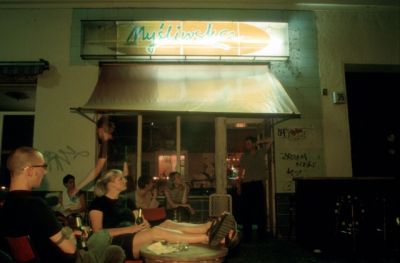Słubfurt and Nowa Amerika

Słubfurt is also a network of contacts that makes everyday life easier for people in the border region. One of these is the so-called “Repair Café”, in which old and defective objects are made ready for use again. Here the inhabitants of both towns carry out the repairs themselves. '”ZeitBankCzasu” also offers a free exchange of mutual services, where anyone can exchange their time and skills for someone else's time and skills. This idea has resulted in reciprocal courses in Polish and German, translations of certificates, and jogging groups on both sides of the Oder. In May 2012 the Internet radio Słubfurt, which is operated by radio fans, also went on air. The station offers interviews, announces local events and broadcasts reports several times a month.
The success of Słubfurt prompted German and Polish artists in March 2010 to go one step further and extend the project of the imaginary town to include the whole borderland. Thus, along the Oder and the Neisse river another art project entitled “Nowa Amerika” [New America] was born. Now, however, it not only included the inhabitants of a single town, like Słubfurt, but almost the entire border region from Gubin [Guben] to Szczecin [Stettin]. “Nova America” consists of four “states”: “Lebuser Ziemia”, “Schlonsk” in Silesia, “Terra Incognita” in the Chojna area and “Szczettistan” in the Szczecin area, covering the territories of all the states on the German and Polish sides of the border.
Even though the project is an artistic creation, “Nowa America” has its roots in reality. On the one hand Frederick the Great (1712-1786), the King of Prussia, was partly responsible for the partition of Poland, a fact that the founders of “Nowa Amerika” clearly disapproved of. On the other hand, he succeeded in acquiring new lands like the “Oderbruch” without waging war. It is less well known that Frederick the Great commissioned the drainage of the swamps and moors on the lower course of the Warta. This is how the area known as the “Warthebruch” came into being. The impetus for these measures came from a visit from a delegation of farmers who asked the King for permission to emigrate to America, where they had been promised free land. At home, their areas were repeatedly hit by floods and this had rendered them unusable.[1]
It is said that Frederick the Great told the farmers that he would create a local America for them, a promise which he kept. The drained land was soon settled by peasants to whom the ruler gave houses and arable land and waived taxes. Among them there were many Poles, since the Prussian population had been decimated in the course of many wars.[2] There were also Dutch citizens who knew how to drain swamps better than anyone else.
[1] Beata Bielecka, Obrazki jak z dzikiego zachodu w naszej Ameryce nad Odrą, [in:] Gazeta Lubuska, 21.08.2014, online: http://www.gazetalubuska.pl/wiadomosci/slubice/art/7459547,obrazki-jak-…
[2] Ibid.







